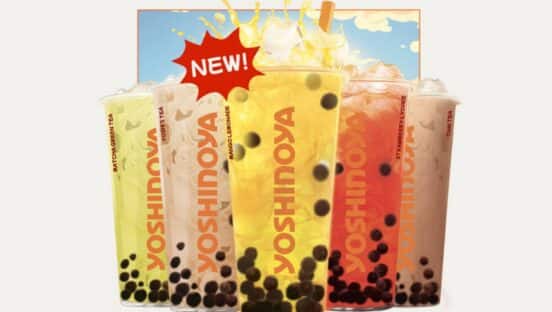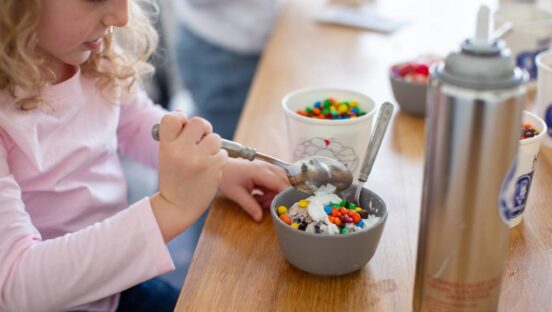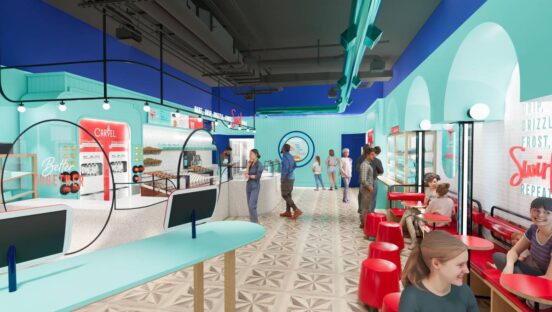Bad Ass Coffee of Hawaii sits at one of those inflections where potential and innovation hold hands in development. There are 28 units open, 12 under construction, and more than 90 sold. So what the legacy brand’s next act looks like remains a fluid question. And one, CEO Scott Snyder feels, Taylor Swift might provide the blueprint for.
Will coffee chains really be a “third-place” five years from now? Five months? Can you walk into a Starbucks and see the mobile-order shelf stacked up and still envision a future where a gathering spot trumps on-the-go, transactional convenience?
The answer isn’t quite as black-and-white as it might seem, Snyder says. Just look at Swift’s “Eras Tour,” which sent Ticketmaster into shambles and spawned class-action lawsuits against the company. It kicked off this past Friday in Glendale, Arizona, and broke Madonna’s record for the most-attended female concert in U.S. history at over 69,000 people.
“People are wanting to gather again and in big numbers,” Snyder says. “I’m not going to say like never before, but people want to gather. They want to be with other people. And coffee being such a social and communal sort of product, and experience, we think it’s important.”
This isn’t to suggest Bad Ass Coffee, which began in 1989 on Hawaii’s Big Island and was sold to Royal Aloha Coffee, LLC in 2019, is going to start opening expansive cafes and abandon to-go, however. It’s far more nuanced.
Given Bad Ass Coffee’s relative size and horizon—the brand awarded 45 franchise agreements last year and opened eight locations—the future is about choice and being nimble, Snyder says. That, he believes, is where the pandemic progressed quick service, and coffee concepts in particular.
“We’re going to design models that meet the needs of the consumer, but also meet the needs of the location,” he says.
There’s no denying COVID reset the category’s trajectory. Even before the crisis, Starbucks’ business had begun to reflect a mobile-powered generation. Some 80 percent of the brand’s customer orders in the U.S. were “on-the-go” pre-pandemic. AKA drive-thru, in a café at point-of-sale, or through mobile order for pickup or delivery.
COVID provided kindling for a combustible trend. This past quarter, mobile order and pay, drive-thru, and delivery delivered 72 percent of domestic revenue for Starbucks. It appreciated mobile order usage at 27 percent of transactions in company units—a record figure.
Snyder says Bad Ass Coffee execs bounced around theories when trying to predict where it all might settle. You still see the third-place, but it’s surely with less regularity. “What we’ve come up with is there are so many people working from home now that they come to the coffee shop in the middle of the day,” he says. “It’s a rest. Which, again, takes us back to the café, right? They want a place. They’ve got to get away from the computer. Get out of the living room or their study. So when they come to the café, that’s a rest, that’s an escape.”
The aim for Bad Ass Coffee is to deliver against all of these evolving points. Not unlike how Starbucks has begun to weigh 90 percent of its growth toward drive-thrus. Meanwhile, the java giant still plans to open Pickup locations, units without cafes, and it also just debuted a 23,000-square foot, three-story Reserve in the Empire State Building, complete with hands-on workshops and guided tasting flights.
At the onset of COVID, Snyder says, coffee disruptions were apparent, thanks mainly to mobility restrictions. Many brands proclaimed they were done with the café. Ghost kitchens sprung up and delivery unlocked the transactional boom of cold beverage innovation. While that wasn’t for everyone, Snyder says, it signaled a changing tide.
This moment also just so happened to coincide with Bad Ass Coffee’s brand relaunch. Cafes in new prototypes were getting smaller. And the chain started designing units without them as well. What’s vital now, though, Snyder says, is to understand what the market calls for instead of knee-jerk reacting to headlines—like “the third-place is dead,” for instance.
“Is it going to be in all of our stores? Nope,” Snyder says of cafes. “But we still think that’s an important element. Especially in store locations that serve as the hub of that community. Whether that’s a downtown location or a small, town center location. Even in our destination locations. Families and couples and individuals who are going on vacation, they want to get that cup of coffee and they want to sit down and relax; enjoy the view.”


Bad Ass Coffee is miles from a sterile, coffee-as-fuel type of concept. The name alone should illustrate that. But if doesn’t, the “aloha” greeting you get walking in and the bright vibe will.
“When you’ve got an experiential brand, like Bad Ass Coffee, where you’re not just walking into another dark industrial coffee shop, you’ve got all sorts of reminders and influence of the Hawaiian culture, and colors and sounds where you feel welcomed,” Snyder says. “That’s another part of it, too, I think. I think in our reaction to solve the issues of COVID, I think we also missed an opportunity for that human exchange.”
To put it plainly, Bad Ass Coffee never thought the café was done and buried. But there’s no lone path left to take, either.
When the company acquired Bad Ass Coffee a year before the crisis hit, there were a lot of growth areas to tackle that would ultimately support today’s transformation. There was no mobile app. Guests couldn’t order ahead. They were very few drive-thrus. That’s all changed. The company is now working on a national third-party delivery program. This past year saw the implementation of Bad Ass Coffee’s first loyalty program and online/mobile ordering system. It rolled a fresh, comprehensive online learning platform for franchisees to streamline communications and training. The company instituted a single POS across the system.
And, uniquely, Snyder and his team were able to be thoughtful about each step and mold systems to where the brand wants to go. It could plan and execute instead of work in reverse.
Most of the Bad Ass Coffee stores being built today boast drive-thrus. “Those are important. Those are important for throughput. Those are important for volume. But I think it comes down to do people have a choice,” Snyder says. “If you’re back to the old grind and your stop to the coffee shop on the way to work is part of your routine, by golly, we’re going to have a drive-thru to make that available to you. If you order ahead and we’ve got the ability to bring it out to your car, you’ve got the ability to run in and run out real quick, that’s fine, too. We’re going to make that available to you.”
Additionally, no matter which avenue guests tap, they’re “still going to get a big aloha when they pick up their drink,” he adds.
That latter point isn’t one to gloss over, Snyder continues. It’s a gap he’s seen form in some concepts as they shifted focus to match digital growth. Along the way, they might have mistaken the demand for convenience as a desire to be treated without hospitality.
An example for Bad Ass Coffee was the rising number of consumers who order ahead but still decide to sit in the café. They want to skirt the line, but not necessarily avoid people altogether. Whether it’s for pickup or at the drive-thru, Snyder says, Bad Ass Coffee trains on making sure its experience translates through the omnichannel. Every guest is going to get the “aloha” greeting and smile that kickstarts their day off right.
In late summer 2022, the brand explored a double drive-thru build that’s become the inspiration for two new prototypes. One is a freestanding drive-thru with a full café that spans roughly 1,650–1,800 square feet. The second is a double-drive thru that’s 500–740 square feet with a pickup window and no interior seating.
It brought Bad Ass Coffee’s suite to five main options for franchisees to choose from: traditional inline, endcap drive-thru, freestanding single or double drive-thru with no indoor seating, freestanding drive-thru with full café, and nontraditional kiosk (grocery, shopping malls, airports, transportation centers, etc.)


The company is even working on a modular version of the double-drive thru that would combine the lanes with dedicated parking spots out front for curbside. In some of these, there will also be the ability to have outside café seating and, potentially, rooftop café tables.
About a quarter of locations currently have drive-thrus. That’s a big change from 2019 when Snyder and a group of investors purchased the brand (under the name Royal Aloha Coffee Company) and moved HQ to Denver. It spent the good part of that first year engaging in branding exercises, mapping out priorities, and building marketing, operations, menu, and technology. Then, COVID came, and as noted, spurred a torrent of changes for the brand.
Bad Ass Coffee opened its first dedicated drive-thru (no café) in December in Las Vegas. At the same time, it opened an Orange Beach, Alabama, venue without a drive-thru. Once more, showcasing how the future will unfold—market-by-market agility versus trying to force a standard box into a trade area. About 75 percent of stores under construction and in the pipeline will offer a drive-thru of some sort.
Returning to the “aloha” DNA, Snyder says you can’t understate how these dots need to connect if you’re going to scale with any success. “Over the last two and half years, we’ve built a training program from scratch,” he says. “There really wasn’t one that existed, and as we’ve really started to focus now on building more of these cafes with drive-thrus, the focus has been on how do you share that aloha spirit in a way that results in a truly remarkable experience?”
“It’s got to come through in the language in the way that they order,” Snyder adds. “It’s got to come through in the experience they have at the corner, the ease that they pay. All of those things are important.”
He admits it’s a big ask. In theory, the entire brand rests on one individual’s ability to be able to communicate that “aloha spirit” to a customer in one transaction without them getting out of the car or seeing what’s happening inside. “So how that is handled and the efficiencies, the technology efficiencies, that can make or break a pleasant experience,” Snyder says. “The last thing you want to have is someone who is frustrated because of this or that.”
Bad Ass Coffee is designing drive-thru menuboards loaded with digital. They’re no longer static and can play in terms of other products or LTOs (some of these last year included The Island Bloom Latte, Beach Bonfire Cold Lava Cold Brew, Cold Brew Lemonade, and Winter Wanderlust LTO). “You’re pulling up to a Hawaiian destination,” Snyder says. “The content and the way that the menu is presented is important but it all rests on the shoulders of the person who is taking your order and giving you the most important cup of the day.”
“What I’m most excited about is we’re really still just getting started,” Snyder says
Development, as it is across the sector, remains a rocky conversation near-term. Bad Ass Coffee has seen some reprieve of late, Snyder says, but he projects 2024 as the year where productivity schedules really get closer to prior norms. Permitting processes that, in the past, were three- or four-week windows have jumped to “months.” It’s just a reality of the climate and not unique to any segment.
Still, the brand recently signed its largest deal in brand history—a 20-unit agreement in Florida. In 2023, the company expects to zero in on the Southeast, Southwest, and Coastal DMAs, in addition to re-establishing its store presence in Hawaii. For now, Bad Ass Coffee expects 20–30 new store openings by year’s-end as it tracks toward a broader goal of 150 openings over the next four years.
Helping fuel interest is top-line growth: According to Bad Ass Coffee’s 2022 FDD, the top 25 percent of stores saw average net sales of more than $1.2 million.
“What I’m most excited about is we’re really still just getting started,” Snyder says. “I think when you have the ability to design an existing brand, kind of wipe the slate clean and design an existing brand with a clean slate, it’s a professional, once-in-a-lifetime opportunity to create the perfect brand. If you can be best practice in every aspect of your brand, from training and operations and marketing, that’s pretty rare.”
On the menu side, he adds, Bad Ass Coffee “basically didn’t have a change for 25 years.” It’s now in the early innings of a “five-year menu innovation project to provide a comprehensive future roadmap for both food and beverage offerings that are on-trend and inspired by Hawaii.”
“In the year ahead, we’re finally going to see all of the stores look and feel the same, with the end of the transition,” Snyder says. “The change from the legacy stores to the new look and feel will be completed this year and I think, really for the first time, we’ll have a pretty consistent experience from store to store and really start to reinforce what this brand is all about.”








